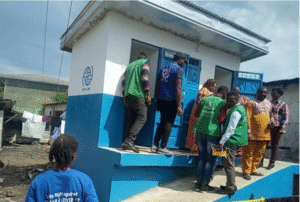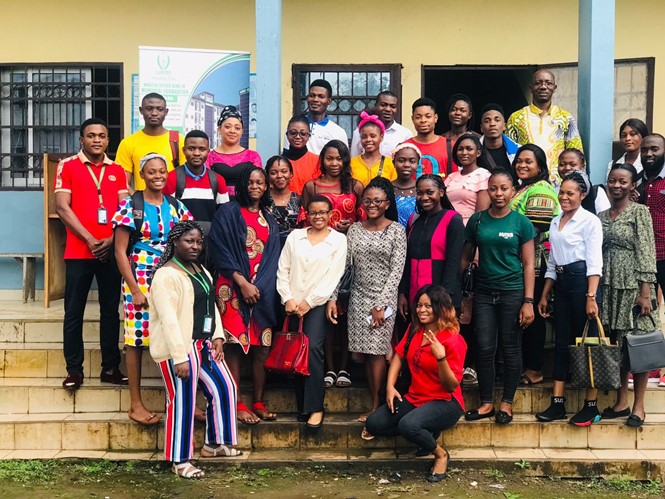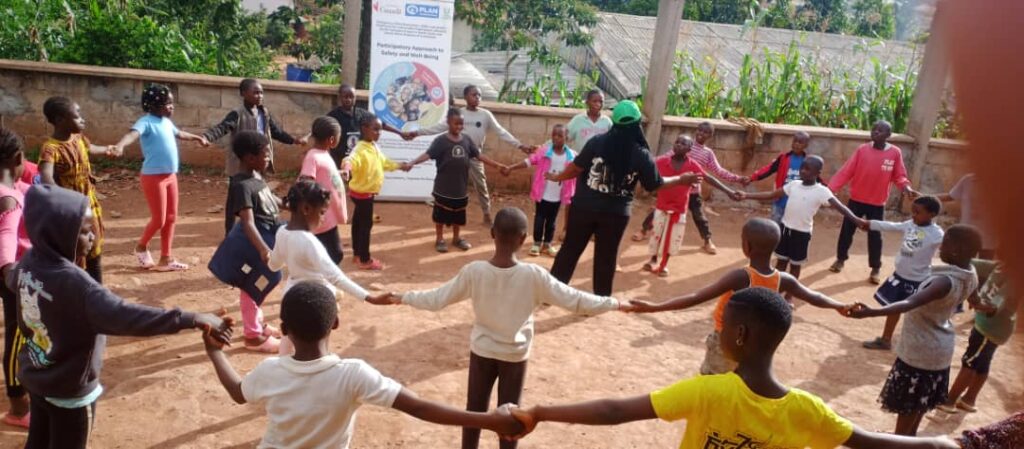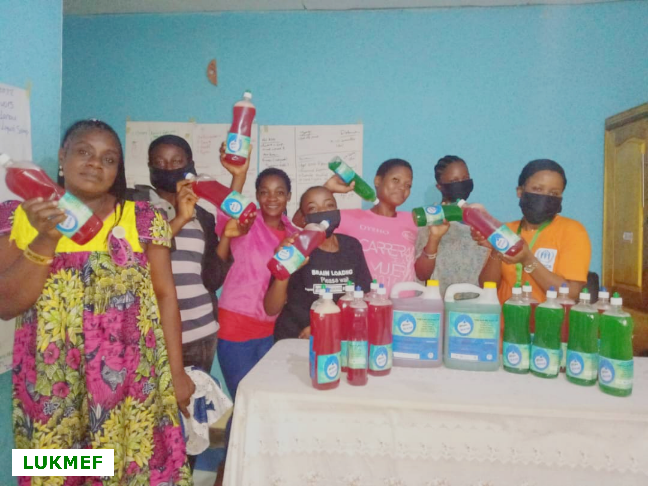A Well of Hope
How Clean Water Restored Dignity and Joy in Wum
A Well of Hope by LUKMEF, IRC with funds from SIDA
In the quiet town of
Wum, tucked in Cameroon’s North-West Region, children once began each school day with a difficult choice — carry heavy jerrycans in search of water or arrive in class late and exhausted. The community’s only borehole had long collapsed, leaving families to fetch water from unsafe streams. For
Grace N., a mother of three and a widow displaced by the conflict, every drop of water came at a cost. “Sometimes I would walk more than an hour just to fill two containers,” she recalls. “My children missed school because of water.”
That changed in late 2024, when a joint project by
LUKMEF, the
International Rescue Committee (IRC), and
SIDA brought back not just water but renewed dignity. As part of the
Humanitarian Framework Agreement on Safety, Basic Needs, and Livelihood Protection, LUKMEF engineers and community volunteers rehabilitated the broken borewell near Wum Primary School. When clean water finally gushed from the spout, the entire neighborhood erupted in cheers. Grace remembers that morning vividly: “It felt like the whole village was reborn. The children laughed and danced around the pump.”
The Wum borewell is one of
eight water points built or restored across the region under the project, giving
3,300 people safe and sufficient drinking water. But the intervention did more than quench thirst—it healed wounds of despair. Communities like
Santa,
Tingoh, and
Obang saw tangible change:
15 VIP latrine blocks with showers were constructed, serving
168 individuals, including
11 persons with disabilities whose homes were adapted for easier access. “I never thought I could bathe in privacy again,” says
Michael, a wheelchair user in Obang. “Now I feel human.”
Beyond infrastructure, the initiative empowered people to sustain these gains.
Water Management Committees were trained and equipped with maintenance toolboxes, and
local borehole repairers learned to troubleshoot and fix hand pumps. Hygiene promoters, many of them women, reached over
8,600 community members, teaching hand-washing, waste management, and disease prevention. These community educators became trusted voices, turning lessons into habits and homes into safer spaces.
Meanwhile, in
Eyumojock and
Kake 1, the project’s
Economic Recovery and Development component offered livelihood support through cash and food-voucher assistance. Households devastated by displacement regained purchasing power, small traders revived their businesses, and youth found purpose again. “Before this help, I couldn’t feed my children,” says
Aisha, a young mother from Eyumojock. “Now I can plan for tomorrow.”
In all, the project touched
11,727 lives—far beyond the original target—proving that when compassion meets community effort, transformation follows. From clean water in Wum to restored livelihoods in Eyumojock, each story reflects resilience born from partnership.
As the sun sets over the Wum hills, the laughter of schoolchildren echoes near the borewell. For Grace, that sound is the music of freedom. “This water is more than water,” she smiles. “It is life returning to us.”
A Dignity Restored
Michael’s Journey from Shame to Strength in Obang

In the small community of
Obang, in Cameroon’s North-West Region, the struggle for dignity was daily reality for
Michael, a 47-year-old father of two who lives with a physical disability. For years, he faced humiliation each time he tried to access the bush to relieve himself. The conflict had not only destroyed homes and livelihoods — it had stripped people of privacy, safety, and basic human dignity.
“I often waited until nightfall,” Michael recalls softly, “just to crawl to the bushes. It was risky, but what choice did I have?”
That reality began to change when
LUKMEF, with support from the
International Rescue Committee (IRC) and
SIDA, launched the
Safety, Basic Needs, and Livelihood Protection Project. The initiative prioritized inclusion, ensuring that people like Michael were not left behind. Through the project,
15 VIP latrine blocks with showers were constructed in Obang, directly benefiting
168 individuals, including
11 persons with disabilities.
For Michael, one of those latrines became more than just a structure — it became freedom. “When I first entered the latrine they built for us, I cried,” he says, smiling now. “For years I was treated like less than human. Today, I feel seen and respected.”
The project didn’t stop at construction. It brought
hygiene promoters to the community who taught families about sanitation and disease prevention, reaching over
8,600 people across neighboring localities. In Obang, these lessons spread quickly. Families began cleaning surroundings, building hand-washing stations, and encouraging children to adopt hygienic habits.
For Michael’s wife, the change has been transformative. “We used to spend hours fetching water and dealing with sickness. Now, we have water nearby, clean surroundings, and Michael can use his latrine without help,” she says proudly.
What began as a humanitarian intervention has become a story of empowerment. By including people with disabilities in planning and implementation, LUKMEF restored more than health — it restored self-worth.
Today, Michael is one of the
community ambassadors teaching others about hygiene and inclusion. “
I want others to know that disability is not inability,” he declares. “
What I received, I must pass on.”
In the heart of Obang, a simple latrine now stands as a symbol of human dignity reborn — a reminder that when aid meets empathy, even the most marginalized can stand tall again.
From Hunger to Hope
Aisha’s New Beginning in Eyumojock
When
Aisha, a 29-year-old mother of three, fled violence in her village, she arrived in
Eyumojock with nothing but her children and a small bundle of clothes. Her husband was missing, her home destroyed, and her business gone. “I felt invisible,” she says. “Every day was about survival.”
Eyumojock, like many communities in Cameroon’s
South-West Region, was reeling from conflict, displacement, and economic collapse. Markets were empty, food prices had tripled, and women like Aisha had lost every source of livelihood.
Through the
IRC–SIDA partnership, LUKMEF launched a
livelihood support program that provided cash and food-voucher assistance to vulnerable households. Aisha was among the hundreds selected through
transparent community targeting and
focus group discussions involving both men and women. “It was the first time I felt my voice mattered,” she recalls.
With her first voucher, Aisha redeemed food supplies that sustained her family for weeks. The second round of support came as a
business grant, which she used to restart her small stall selling soap, oil, and groundnuts. “It was a miracle,” she says. “I could finally feed my children without begging.”
Over time, Aisha joined a
feedback committee, ensuring others in her community could express concerns and ideas. “This project didn’t just give us food — it gave us confidence,” she says.
Across Eyumojock and neighboring
Kake 1 (Meme Division), the initiative helped families recover from the brink of starvation. It reawakened local trade, reduced dependency, and empowered women to take leadership roles in their communities.
Aisha now dreams of expanding her business. “
If I can save enough, I’ll buy a sewing machine and start making clothes,” she says, her eyes bright. “My children will not suffer as I did.”
To many, her success might seem small. But in a conflict zone where despair was once the norm, Aisha’s journey is a revolution.
“People used to say nothing good can come from war,” she reflects. “
But I’ve learned that with support and courage, even ashes can grow flowers.”
Her words echo what the project has proven — that when humanitarian aid is rooted in dignity, participation, and empowerment, it does more than save lives.
It rebuilds them.





 In the small community of Obang, in Cameroon’s North-West Region, the struggle for dignity was daily reality for Michael, a 47-year-old father of two who lives with a physical disability. For years, he faced humiliation each time he tried to access the bush to relieve himself. The conflict had not only destroyed homes and livelihoods — it had stripped people of privacy, safety, and basic human dignity.
“I often waited until nightfall,” Michael recalls softly, “just to crawl to the bushes. It was risky, but what choice did I have?”
That reality began to change when LUKMEF, with support from the International Rescue Committee (IRC) and SIDA, launched the Safety, Basic Needs, and Livelihood Protection Project. The initiative prioritized inclusion, ensuring that people like Michael were not left behind. Through the project, 15 VIP latrine blocks with showers were constructed in Obang, directly benefiting 168 individuals, including 11 persons with disabilities.
For Michael, one of those latrines became more than just a structure — it became freedom. “When I first entered the latrine they built for us, I cried,” he says, smiling now. “For years I was treated like less than human. Today, I feel seen and respected.”
The project didn’t stop at construction. It brought hygiene promoters to the community who taught families about sanitation and disease prevention, reaching over 8,600 people across neighboring localities. In Obang, these lessons spread quickly. Families began cleaning surroundings, building hand-washing stations, and encouraging children to adopt hygienic habits.
For Michael’s wife, the change has been transformative. “We used to spend hours fetching water and dealing with sickness. Now, we have water nearby, clean surroundings, and Michael can use his latrine without help,” she says proudly.
What began as a humanitarian intervention has become a story of empowerment. By including people with disabilities in planning and implementation, LUKMEF restored more than health — it restored self-worth.
Today, Michael is one of the community ambassadors teaching others about hygiene and inclusion. “I want others to know that disability is not inability,” he declares. “What I received, I must pass on.”
In the heart of Obang, a simple latrine now stands as a symbol of human dignity reborn — a reminder that when aid meets empathy, even the most marginalized can stand tall again.
In the small community of Obang, in Cameroon’s North-West Region, the struggle for dignity was daily reality for Michael, a 47-year-old father of two who lives with a physical disability. For years, he faced humiliation each time he tried to access the bush to relieve himself. The conflict had not only destroyed homes and livelihoods — it had stripped people of privacy, safety, and basic human dignity.
“I often waited until nightfall,” Michael recalls softly, “just to crawl to the bushes. It was risky, but what choice did I have?”
That reality began to change when LUKMEF, with support from the International Rescue Committee (IRC) and SIDA, launched the Safety, Basic Needs, and Livelihood Protection Project. The initiative prioritized inclusion, ensuring that people like Michael were not left behind. Through the project, 15 VIP latrine blocks with showers were constructed in Obang, directly benefiting 168 individuals, including 11 persons with disabilities.
For Michael, one of those latrines became more than just a structure — it became freedom. “When I first entered the latrine they built for us, I cried,” he says, smiling now. “For years I was treated like less than human. Today, I feel seen and respected.”
The project didn’t stop at construction. It brought hygiene promoters to the community who taught families about sanitation and disease prevention, reaching over 8,600 people across neighboring localities. In Obang, these lessons spread quickly. Families began cleaning surroundings, building hand-washing stations, and encouraging children to adopt hygienic habits.
For Michael’s wife, the change has been transformative. “We used to spend hours fetching water and dealing with sickness. Now, we have water nearby, clean surroundings, and Michael can use his latrine without help,” she says proudly.
What began as a humanitarian intervention has become a story of empowerment. By including people with disabilities in planning and implementation, LUKMEF restored more than health — it restored self-worth.
Today, Michael is one of the community ambassadors teaching others about hygiene and inclusion. “I want others to know that disability is not inability,” he declares. “What I received, I must pass on.”
In the heart of Obang, a simple latrine now stands as a symbol of human dignity reborn — a reminder that when aid meets empathy, even the most marginalized can stand tall again.